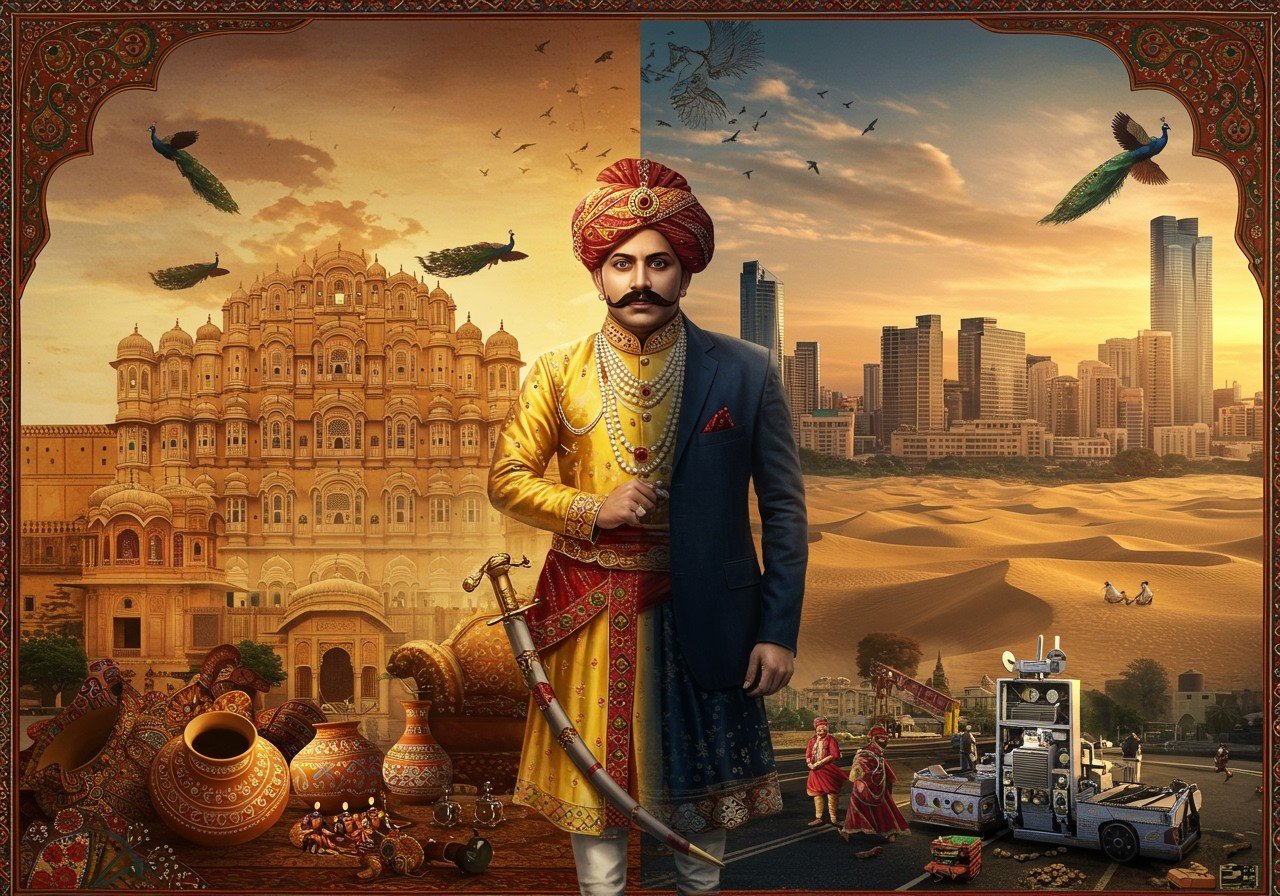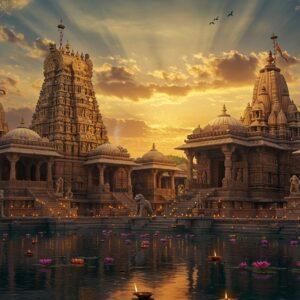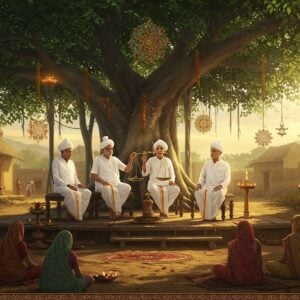
Rajasthan, the “Land of Kings,” is a captivating state in northern India, renowned for its rich heritage and vibrant culture. This blog post delves into Rajasthan’s modern history, tracing its evolution from a collection of princely states to its present-day form. We’ll explore the pivotal events and transformations that have molded Rajasthan over the decades, offering a comprehensive overview for those who appreciate tradition and history.
Modern History of Rajasthan
Key Events and Developments
- Integration Post-Independence (1947): Following India’s independence in 1947, the princely states of Rajasthan gradually integrated into the Indian Union. This complex process involved negotiations and agreements with various rulers, culminating in the formation of the present-day state of Rajasthan on November 1, 1956. The Rajputana Agency, a British political office, had previously overseen these states.
- Prominent Leaders: Leaders like Sawai Man Singh II, the Maharaja of Jaipur, played a crucial role in this transition. His influence and diplomacy were essential in uniting the diverse princely states under a single banner.
- States Reorganization Act (1956): This act significantly impacted Rajasthan’s territorial boundaries, shaping its current geographical structure. The reorganization aimed to create more cohesive administrative units within India.
- Land Reforms: The abolition of the zamindari system brought about profound socio-economic changes. This reform empowered farmers and redistributed land ownership, leading to a more equitable agricultural landscape.
- Infrastructure Growth: Rajasthan experienced substantial development in infrastructure, including roads, industries, tourism facilities, and support for traditional handicrafts. This growth modernized the state while preserving its cultural heritage.
- Cultural Revival: Significant efforts were made to preserve Rajasthan’s heritage sites, including the restoration of historical buildings and the promotion of traditional arts and crafts. This focus on cultural preservation helped maintain Rajasthan’s unique identity.
- Urban Development: Jaipur, the capital city, emerged as a major urban center, known for its stunning architecture and bustling markets. Jaipur symbolizes Rajasthan’s successful blend of tradition and modernity.
Rajasthan’s Post-Independence Journey
The Path to Modernity
- Integration Challenges (Post-1947): Integrating the diverse cultural backgrounds of the former princely states presented significant challenges. Reconciling different traditions and administrative systems required careful planning and execution.
- Political Landscape: Key elections and the formation of a state government marked the development of Rajasthan’s political system. Leaders from various backgrounds worked together to establish a stable and representative government.
- Economic Development: Policy initiatives focused on economic growth and social welfare played a pivotal role in Rajasthan’s progress. These policies aimed to improve living standards and create opportunities for all citizens.
- Role in National Politics: Rajasthan has contributed significantly to national politics, with prominent leaders from the state holding key positions in the Indian government. Their influence helped shape national policies and priorities.
- Impact of Modernization: Modernization brought about changes in traditional practices and lifestyles. While embracing new technologies and ideas, the people of Rajasthan continued to value their cultural heritage.
- Educational Institutions: The growth of educational institutions played a vital role in shaping Rajasthan’s future. Schools, colleges, and universities provided access to quality education, contributing to social progress and economic development.
- Milestones Achieved: Rajasthan reached significant milestones on its path to becoming a modern state. These achievements demonstrated the resilience and determination of its people.
राजस्थान का आधुनिक इतिहास (Modern History of Rajasthan in Hindi)
आधुनिकता की ओर राजस्थान का सफर
- राजस्थान का एकीकरण (1947 के बाद): स्वतंत्रता के बाद, राजस्थान की रियासतों का भारत संघ में विलय एक महत्वपूर्ण घटना थी। यह प्रक्रिया कई चरणों में हुई और 1 नवंबर 1956 को वर्तमान राजस्थान राज्य का गठन हुआ।
- प्रमुख नेता: जयपुर के महाराजा सवाई मान सिंह द्वितीय जैसे नेताओं ने इस परिवर्तन में महत्वपूर्ण भूमिका निभाई।
- राज्यों का पुनर्गठन अधिनियम (1956): इस अधिनियम ने राजस्थान की क्षेत्रीय सीमाओं को प्रभावित किया और वर्तमान भौगोलिक संरचना को आकार दिया।
- भूमि सुधार: जमींदारी प्रथा के उन्मूलन ने सामाजिक-आर्थिक परिवर्तन लाए और किसानों को सशक्त बनाया।
- आधारिक संरचना विकास: सड़कों, उद्योगों, पर्यटन और हस्तशिल्प के विकास ने राजस्थान के आधुनिकीकरण में योगदान दिया।
- सांस्कृतिक पुनरुत्थान: ऐतिहासिक इमारतों के जीर्णोद्धार और पारंपरिक कला और शिल्प को बढ़ावा देकर राजस्थान की सांस्कृतिक विरासत को संरक्षित करने के प्रयास किए गए।
- शहरी विकास: राजधानी जयपुर एक प्रमुख शहरी केंद्र के रूप में उभरा, जो अपनी वास्तुकला और बाजारों के लिए प्रसिद्ध है।
Cultural and Social Transformation
Changes Over the Years
Globalization has significantly influenced Rajasthani culture and traditions. The advent of media and technology has brought about changes in lifestyles and social interactions. Despite these changes, traditional arts, crafts, and festivals continue to thrive, showcasing the resilience of Rajasthani culture.
Women play a crucial role in Rajasthan’s social transformation, with increasing contributions to education and the workforce. Rajasthani cuisine, fashion, and entertainment have evolved while still retaining their unique regional flavors and characteristics. Efforts to promote sustainable tourism and eco-friendly practices are gaining momentum, reflecting a growing awareness of environmental conservation.
Community initiatives focused on preserving cultural heritage and promoting social welfare are strengthening the fabric of Rajasthani society. These initiatives foster a sense of collective responsibility and empower local communities to participate in their own development.
Economic Development and Challenges
Growth and Initiatives
Tourism is a major economic driver for Rajasthan, attracting visitors from around the world. Industries such as textiles, mining, and handicrafts have experienced significant growth, contributing to the state’s economy. Infrastructure development, including roads, airports, and railways, has improved connectivity and facilitated trade.
While the agricultural sector faces challenges, various initiatives are underway to improve productivity and support farmers. Government policies on investment and trade are designed to foster economic development and create a favorable business environment.
Entrepreneurship and innovation are playing an increasingly important role in shaping Rajasthan’s economy. Efforts to address socio-economic disparities aim to promote inclusive growth and ensure that the benefits of development reach all segments of society.
Traditional Mats and Textiles in Modern Rajasthan
Rajasthan’s rich textile heritage includes the famous Durrie (also called Dari or Durry), which remains an integral part of modern Rajasthani homes and religious ceremonies. At Poojn.in, we offer authentic Rajasthani Durries that beautifully blend traditional craftsmanship with modern convenience. You can explore our collection of sandalwood rubbing stones and other puja essentials to enhance your spiritual practices.
These handwoven mats, available at our online store, serve a multitude of purposes in religious ceremonies and daily life. Crafted from high-quality cotton and wool, our Durries showcase traditional Rajasthani patterns that reflect the state’s cultural heritage. For religious ceremonies and meditation, these mats provide a sacred space, connecting modern practitioners with ancient traditions.
Poojn.in makes it easy to access these traditional items through our user-friendly website, with detailed product descriptions and secure delivery across India. We ensure that each Durrie upholds the authenticity of Rajasthani craftsmanship while meeting modern quality standards. Beyond Durries, we also offer related items like Asanas and prayer mats, complementing Rajasthani religious practices. Each product in our collection helps preserve and continue Rajasthan’s rich textile traditions in the modern era.
Conclusion
Rajasthan’s journey from a collection of princely states to its modern form is a testament to its resilience and capacity for transformation. The integration post-independence, land reforms, infrastructure growth, and cultural revival have been pivotal in shaping its identity. Prominent leaders and well-planned policy initiatives have guided the state’s political and economic landscape.
The harmonious blend of tradition and modernity is evident in urban centers like Jaipur, symbolizing Rajasthan’s vibrant heritage and progressive spirit. Through challenges and milestones, Rajasthan continues to thrive, retaining its unique cultural identity. The state’s rich history, combined with modern advancements, promises a bright future for its people.


